Share this
Loadsmart First Look Monthly Lowdown with Jim Nicholson and Kyle Lintner (K-Ratio)
by aaronroseman
Welcome to October’s Monthly Episode of Loadsmart First Look. This is a monthly series that dives into the domestic freight market, the economy as a backdrop to the trucking industry, and the latest developments and technologies that are changing the supply chain.
This month Jim Nicholson, VP of Operations at Loadsmart is joined by Kyle Lintner, Partner and Managing Director of K-Ratio to—among many things— discuss leveraging principles from the financial markets to improve efficiency in the freight industry, what a central clearinghouse for freight transactions would mean for the industry, and how universally agreed upon rate transparency might improve the flow of goods through the supply chain.
Lightning Round:
Jim: Outbound tender volume index will stay above 15,000 for 2020
Kyle: False, but not by much
Jim: Tender rejections will drop below 20% by the end of the year
Kyle: False
Jim: Tender rejections will drop below 10% in Q1
Kyle: That is a really tough one. False, but very very close.
Jim: Capacity in the marketplace will end up lower than where we went into it this year. So capacity will drop
Kyle: No, false.
Jim: Shippers will opt to move a smaller percent of their volume in contracts
Kyle: They will not put more stuff into spot, even though sometimes I think it does, flex contracts, option contracts, spot business whatever you call it, they’re going to run it on all three dedicated
Jim: Hottest trend in 2021 will be…
Kyle: More visibility
Jim: What introduced you to the freight markets?
Kyle: A long time friend of mine was an executive at a mid-size trucking company here in Chicago. I had been happily trading financial markets, but in advance of the freight futures market, he had read some literature by FreightWaves right when they were just getting started. He’d actually just come back from the first conference they’ve ever had when they announced the upcoming freight futures market. He called me up and said ‘hey, there’s this new marketplace opening, would you mind just taking a look at our books here as far as risk is concerned’ at the small trucking company. I said sure I’ll come in to try and teach you guys what’s going on and what this looks like in terms of how your company is concerned and who your competitors are.
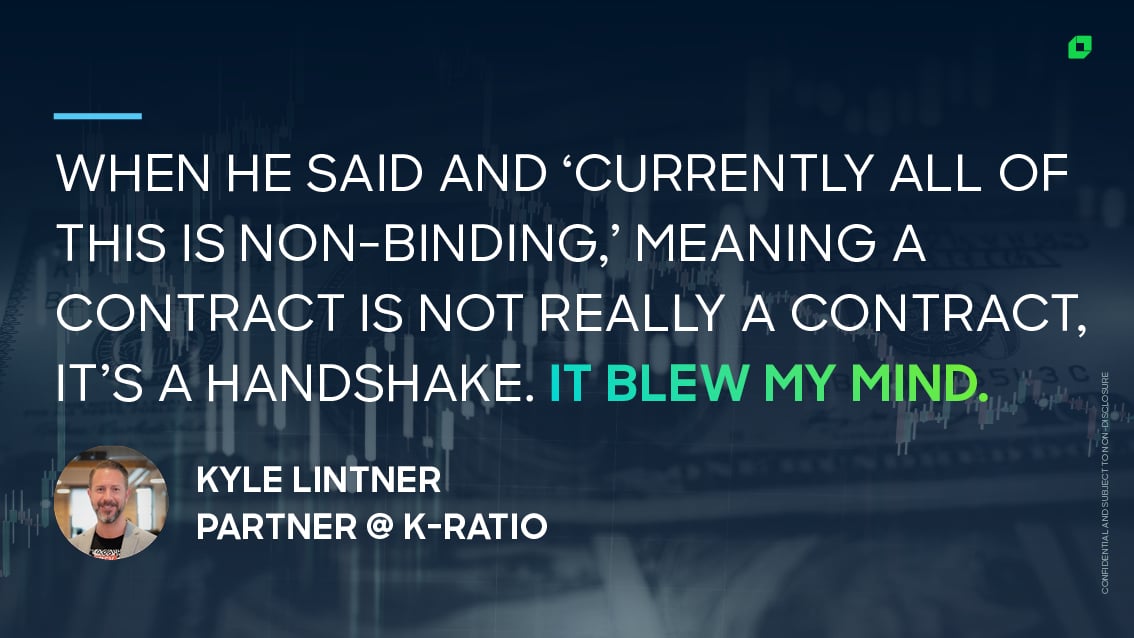
Naively, I didn’t know exactly how logistics or freight worked and I started asking some questions to see how stuff fit into place. And when he started throwing some numbers at me like the size of it —800 plus million—the amount of companies that are participating and how broad it is I started to get interested. When he said and ‘currently all of this non-binding,’ meaning contract is not really a contract, it’s just sort of paper rates, handshake agreements, companies can fail 10-15% on primary and still maintain. He started throwing phrases like that at me and it just blew my mind.
Jim: Why do you think it took so long to bring some principles from the finance industry to the fright markets?
Kyle: It’s a factor of how big the market really is. So if it is this size and people throw out all types of statistics—no one trucking company is more than 2%, no one brokerage is more than 2% of the market—those types of things and then the other side of it is 96% of trucking companies are six trucks or less.
Those are really used to display the amount of fragmentation of the marketplace, but really I think it’s the breadth of the marketplace. And what I mean by that is so many companies can survive and can exist because there is so much business to be done. It’s an industry where you can throw bodies at the problem. So that allows for the inefficiencies and some of the slack I call it that we see. You just need someone to move the freight, right?
Jim: What needs to happen to achieve this similar rate of acceleration and digital transactions?
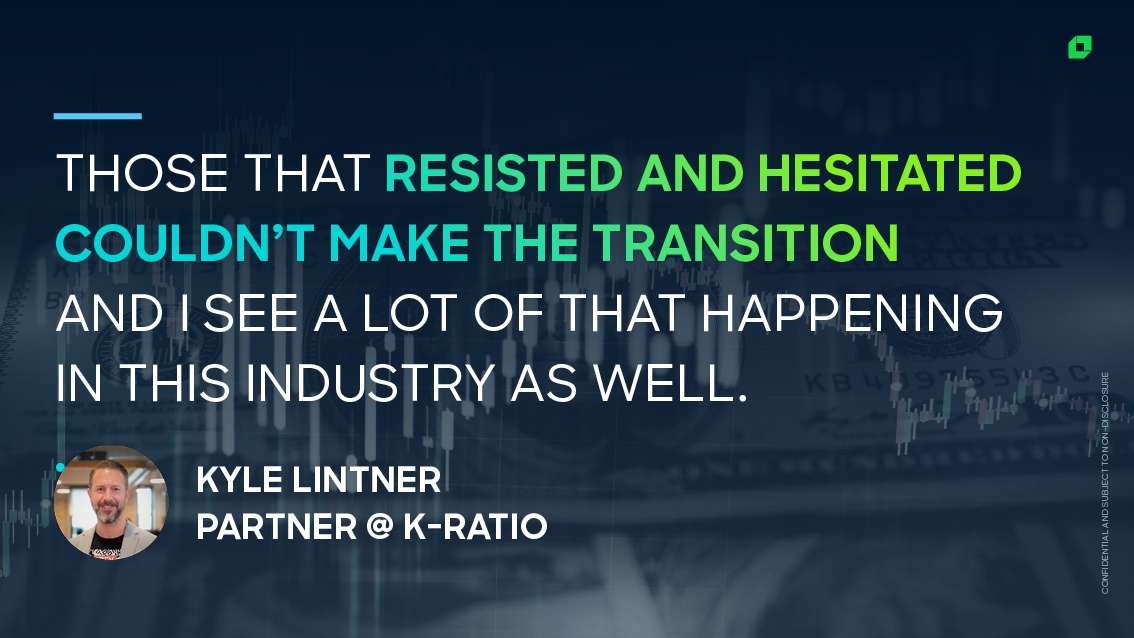
Kyle: You mentioned the trading floor and that’s one of the things people who know me ask about because I make a lot of comparisons between this industry and the previous one I was in. I witnessed that revolution and that digitization first hand. I was one of those people—if anyone is old enough to see a trading place—I was one of those people who was standing in a pit and yelling and screaming all day and writing on paper. I wasn’t hesitant to change and I was not resistant when computerization came along. I had to make a transition from standing on a floor and yelling to sitting at a computer and clicking a mouse. I enjoyed that it allows you to do that anywhere you want and in any clothing you want. But a lot of people didn’t. Those that resisted and hesitated were the ones who couldn’t make the transition and I see a lot of that happening in this industry as well.
If you think about just how business was conducted, people were yelling and screaming and writing on paper to conduct trades. If you think of freight now, from a broker perspective, matching a carrier with a load. It’s the same thing, it used to be done by 1-800 dial a truck, when you think of DAT. Now we have other people in this atmosphere that are trying to do the same stuff digitally that they had done in the financial world. So if you can match John Smith carrier with ABC shipping and do it digitally and do it faster you’ve reduced your overhead and your costs similar to financial transactions. It doesn’t cost you anything now you don’t need the same manpower employed to do so. And it allows you to be far more accurate. And you get second and third order effects in terms of what you can record and learn from from a data perspective.
It was very interesting for me to have already seen this one and now to be a part of it on the second end—it’s something that’s going to happen regardless and the more people who get on board sooner the better we’re all gonna be and the better they’re gonna be
Jim: What needs to happen?
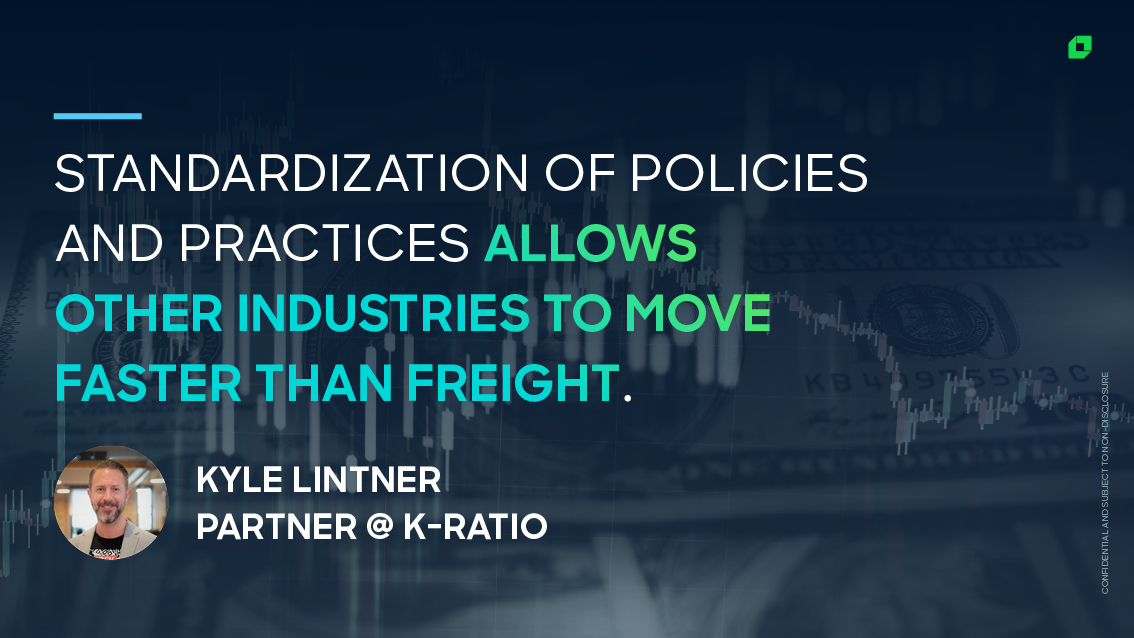
Kyle: Standardization of policies and practices. That’s what allows other industries to move faster than freight because there are best practices that are accepted by the entire industry or there is some sort of loose government watchdog who says this is how we’re going to do that. We had a little taste of that with ELDs. That mandate came in and everyone has to have it so now the providers servicing that device are some of the biggest players in the data space.
But until we have everyone at least agreeing what trucks need to carry on board it’s going to be hard to say this will be the uniform standard that we are going to deal with data and these are the categories we’re going to record without infringing personal privacy concerns. Because that’s what we hear from truck drivers. They don’t want to feel like some type of robot, someone tracked 24/7 and that’s very understandable, but at the same time they are hauling someone else’s goods in the back of their truck.
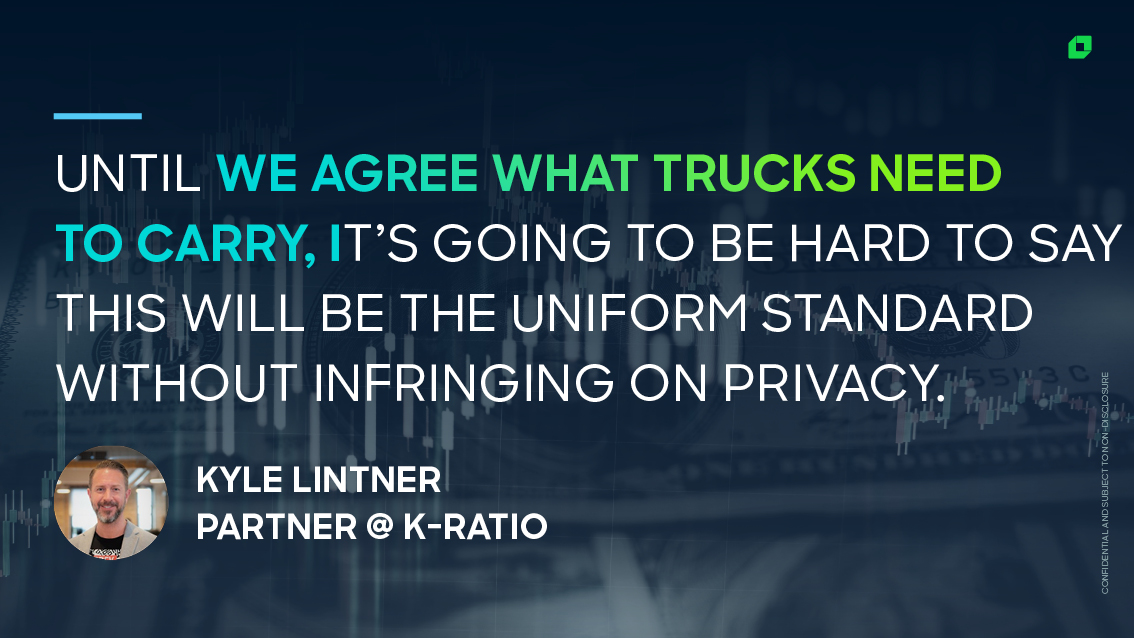
So there’s a give and play with that in terms of who has the rights to what, but once that gets irons out we can get into the assimilation of all of the data regarding the truck as far as where it is and when it is and once we get that the other aspects whether its shipment data from either a broker or shipper; those are fairly more standard because now you have some uniformity of the players in terms of who’s running them and what they’re trying to achieve. If we can match those two together, if we can figure out when and where trucks are combined with what we have from shipment side data. Now we can have all these fun ideas around optimization.
Jim: So you would have something like LIBOR: a central agreed upon principle that businesses trade on?
Kyle: If we do have something out there and I know you mentioned LIBOR which is a good way to think about it. If we had a central clearing house of rates, where everyone submitted or at least a large enough market share submitted price data and we had an average daily published rate.
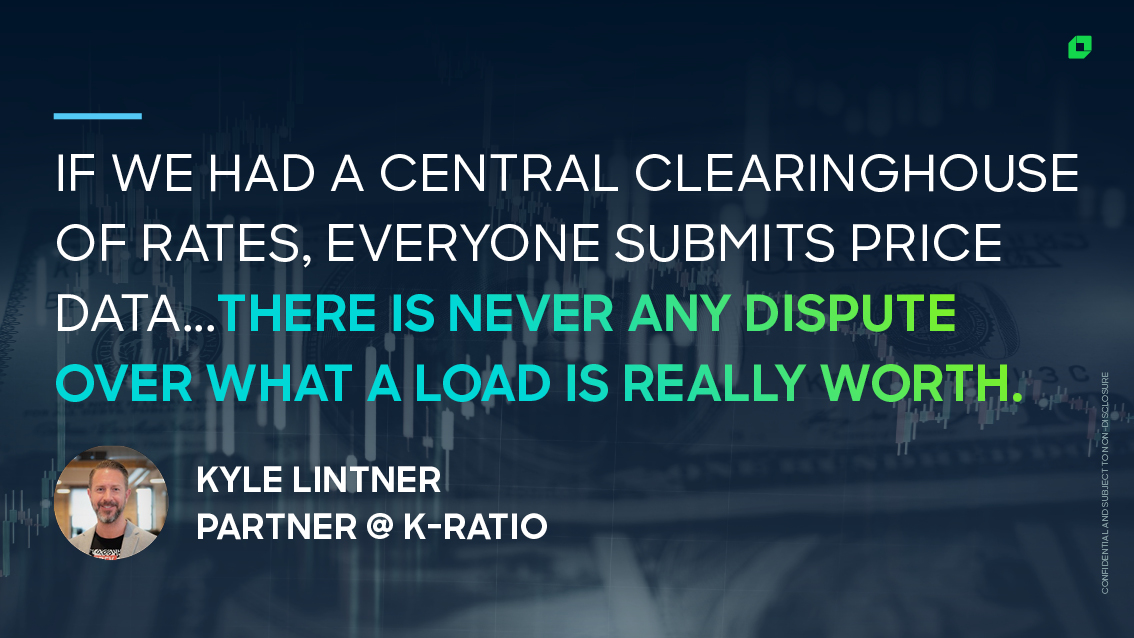
Now we can take that one step further and that average daily published rate is something we can conduct business on. You can have agreements between a shipper and a provider where that daily published rate serves at the base and a layer of service and margin is applied on top of that. This way there is never any dispute around what a load really worth. You can go back to that cost plus or market plus model here you’re just agreeing to do the business and you let it float at whatever that rate may be. And now you get into financial transactions because you can create future indexes on top of those daily published rates, similar to LIBOR, and now you have a risk management tool that can reduce balance sheet risk for any of those same participants that are just conducting their operational business of that same rate.
Jim: This is a massive industry with a lot of old school thought still entrenched in it. What is our biggest challenge to agree upon this path?
Kyle: I do see it happening just because it makes too much sense and it happens in every other business. As far as when it happens here, the adoption here is slow just because of some of the problems we mentioned earlier just in terms of tracking data or even optimizing your own business – this is a slow to change industry.
It happens when not only do we reach some sort of critical mass in market share, but really when the shippers realize that they have all the power in this and we have one or two large shippers say this is what we want, anyone who wants to do business with us has to do it this way. Then all of a sudden everyone else gets in line.
Stay Up to Date
With all the latest weekly and monthly market insights on our Youtube page. Questions about anything you saw? Email sales@loadsmart.com and let’s talk about how we can help you take advantage of real-time market conditions.
Share this
- Loadsmart Blog (159)
- Blog (121)
- Shipper (106)
- Market Trends (99)
- Enterprise Shipper (69)
- Carrier (66)
- News (62)
- Data Insights (51)
- Thought Leadership (45)
- Warehouse (41)
- SMB Shipper (38)
- Our Partners (34)
- ShipperGuide TMS (31)
- Opendock (30)
- Product Updates (29)
- Mode Optimization (25)
- Loadsmart (23)
- Mid-Market Shipper (18)
- Case Study (17)
- Brokerage Services (15)
- Managed Transportation (11)
- Video (9)
- Award (7)
- FreightIntel AI (5)
- Instant Execution (4)
- Asset (3)
- Food and Beverage (3)
- Freight Management (3)
- Logistics Solutions (3)
- YMS (3)
- eBook (3)
- 4PL (2)
- International (2)
- NavTrac (2)
- Podcast (2)
- UK (2)
- Yard Management System (2)
- Cold Storage (1)
- Faces of Loadsmart (1)
- Paper Packaging (1)
- Retail (1)
- Security (1)
- Transportation Management System (1)
- November 2025 (1)
- October 2025 (2)
- September 2025 (1)
- August 2025 (1)
- July 2025 (1)
- June 2025 (1)
- May 2025 (7)
- April 2025 (6)
- March 2025 (3)
- February 2025 (10)
- January 2025 (4)
- December 2024 (4)
- November 2024 (5)
- October 2024 (11)
- September 2024 (11)
- August 2024 (5)
- July 2024 (5)
- June 2024 (9)
- May 2024 (7)
- April 2024 (6)
- March 2024 (2)
- February 2024 (2)
- January 2024 (5)
- December 2023 (6)
- November 2023 (2)
- October 2023 (12)
- September 2023 (5)
- August 2023 (3)
- July 2023 (4)
- June 2023 (10)
- May 2023 (5)
- April 2023 (5)
- March 2023 (7)
- February 2023 (5)
- January 2023 (7)
- December 2022 (4)
- November 2022 (13)
- October 2022 (4)
- September 2022 (7)
- August 2022 (11)
- July 2022 (6)
- June 2022 (5)
- May 2022 (2)
- April 2022 (4)
- March 2022 (6)
- February 2022 (7)
- January 2022 (9)
- December 2021 (3)
- November 2021 (5)
- October 2021 (7)
- September 2021 (2)
- August 2021 (2)
- July 2021 (4)
- June 2021 (6)
- May 2021 (6)
- April 2021 (5)
- March 2021 (8)
- February 2021 (3)
- January 2021 (3)
- December 2020 (7)
- November 2020 (9)
- October 2020 (7)
- September 2020 (6)
- August 2020 (10)
- July 2020 (8)
- June 2020 (3)
- May 2020 (1)
- April 2020 (2)
- March 2020 (2)
- February 2020 (1)
- January 2020 (1)
- November 2019 (2)
- October 2019 (1)
- September 2019 (2)
- August 2019 (3)
- July 2019 (2)
- June 2019 (2)
- May 2019 (3)
- March 2019 (1)
- February 2019 (3)
- December 2018 (1)
- November 2018 (2)
- October 2018 (1)
- September 2018 (2)
- August 2018 (1)
- July 2018 (1)
- June 2018 (3)
- May 2018 (4)
- April 2018 (1)
- February 2018 (1)
- January 2018 (4)
- November 2017 (1)
- October 2017 (2)
- June 2017 (1)
- May 2017 (2)
- April 2017 (1)
- February 2017 (1)
- January 2017 (2)
- October 2016 (1)
- August 2016 (1)
- July 2016 (2)
- June 2016 (1)
- March 2016 (1)
- January 2016 (1)
- December 2015 (3)
- November 2015 (2)
- October 2015 (6)
- July 2015 (1)
- June 2015 (1)
- April 2015 (2)
- March 2015 (13)
- February 2015 (17)
- January 2015 (15)
- December 2014 (35)
- November 2014 (26)
- October 2014 (60)
- September 2014 (2)